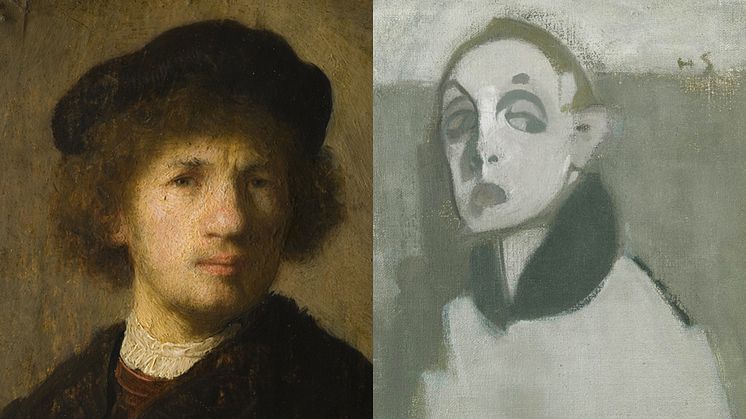
Press release -
Outstanding collections meet in exhibition about the role of the artist
Nationalmuseum, Moderna Museet and Konstakademien in Sweden are showcasing the strengths of their respective collections by bringing together works from different eras in a co-produced exhibition titled The Artist. The exhibition examines the various roles of the artist, and the associated norms, ideals and myths. On show will be close to 100 works by some of the biggest names in art history, from Rubens and Rembrandt via Renoir and Picasso to Cindy Sherman.
The Artist is an exhibition that discusses what it means to be an artist, in both a contemporary and a historical context. The exhibition examines roles, ideals and myths, illustrating how artists have related to the values, audiences and markets of their time. It also looks at the power relationships constructed around notions of gender, ethnicity, sexuality and class. The ideal and the norms have changed over the course of history, but many of the roles and issues persist or return in a new form.
The role of the artist is anything but uniform. The court painter undertaking commissions for clients is a far cry from the bohemian wishing to live a life unshackled by establishment values. The exhibition considers a variety of artistic roles, as well as the myths surrounding them. It also shows just how numerous and influential female artists have been, and how they shook up the accepted notion of artists as male in the 1870s and ’80s.
In recent times, many artists have taken on the role of entrepreneur. Jeff Koons and Ernst Billgren, for instance, resemble modern business owners in a commercial market. In their time, too, Rosa Bonheur and Anders Zorn were extremely adept at building their personal brands, which helped them achieve huge success in the international market of the late 19th century. Even in the 17th-century Netherlands, the entrepreneurial artist played an important role, with Rembrandt and other Dutch painters finding clients among the emerging bourgeoisie.
The exhibition also illustrates artists’ attitudes to travel and other cultures through examples from history, including Egron Lundgren, Paul Gauguin and Ivan Aguéli. Sometimes, artists’ concepts of cultures foreign to them have been full of preconceived ideas and stereotypes, but there are also plenty of examples of artists who have worked to expose power structures and norms, Vibeke Tandberg and Meriç Algün Ringborg, for instance.
Throughout history, many artists have seen themselves as visionaries or prophets. Feminist artists like Siri Derkert and Gittan Jönsson have been critical of contemporary society while offering political visions of the future. Other artists have been concerned with visions of a more spiritual nature. This might involve seeking to connect the onlooker with inner worlds and spiritual dimensions, as in the works of the early 20th-century modernists Hilma af Klint and Vasily Kandinsky.
Co-produced by Konstakademien (The Royal Academy of Fine Arts), Moderna Museet and Nationalmuseum, the exhibition features art from the collections of these three institutions. On show will be close to 100 works by some of the biggest names in art history, from Rubens and Rembrandt via Renoir and Picasso to Cindy Sherman. To round out the exhibition, a small number of key works have been obtained on loan from other collections. The curatorial team comprises Margareta Gynning, Per Hedström and Carl Johan Olsson from Nationalmuseum, John Peter Nilsson and Andreas Nilsson from Moderna Museet Malmö, and Eva-Lena Bengtsson from Konstakademien. A lavishly illustrated catalogue containing articles by the curatorial team will be published to accompany the exhibition.
The Artist opens on 11 February 2016 in Nationalmuseum’s temporary galleries at Konstakademien, and runs until 4 September 2016. It will then appear at Moderna Museet Malmö from 24 September 2016 to 19 February 2017.
Press contact
Hanna Tottmar, Press Officer, hanna.tottmar@nationalmuseum.se, +46 767 234632
Caption
Rembrandt, Self-Portrait, 1630; Helene Schjerfbeck, Self-portrait with Palette, 1937. Photo: Nationalmuseum (Rembrandt) and Albin Dahlström/Moderna Museet (Schjerfbeck).
Categories
Nationalmuseum is Sweden’s premier museum of art and design. The collections comprise older paintings, sculpture, drawings and graphic art, and applied art and design up to the present day. The museum building is currently under renovation and scheduled to open again in 2018. In the meantime, the museum will continue its activities through collaborations both in Sweden and abroad as well as temporary exhibitions at the Royal Swedish Academy of Fine Arts, Fredsgatan 12 and Nationalmuseum Design at Kulturhuset Stadsteatern in Stockholm. Nationalmuseum has partnerships with Svenska Dagbladet and the Grand Hôtel Stockholm, and acknowledges the support of FCB Fältman & Malmén.

